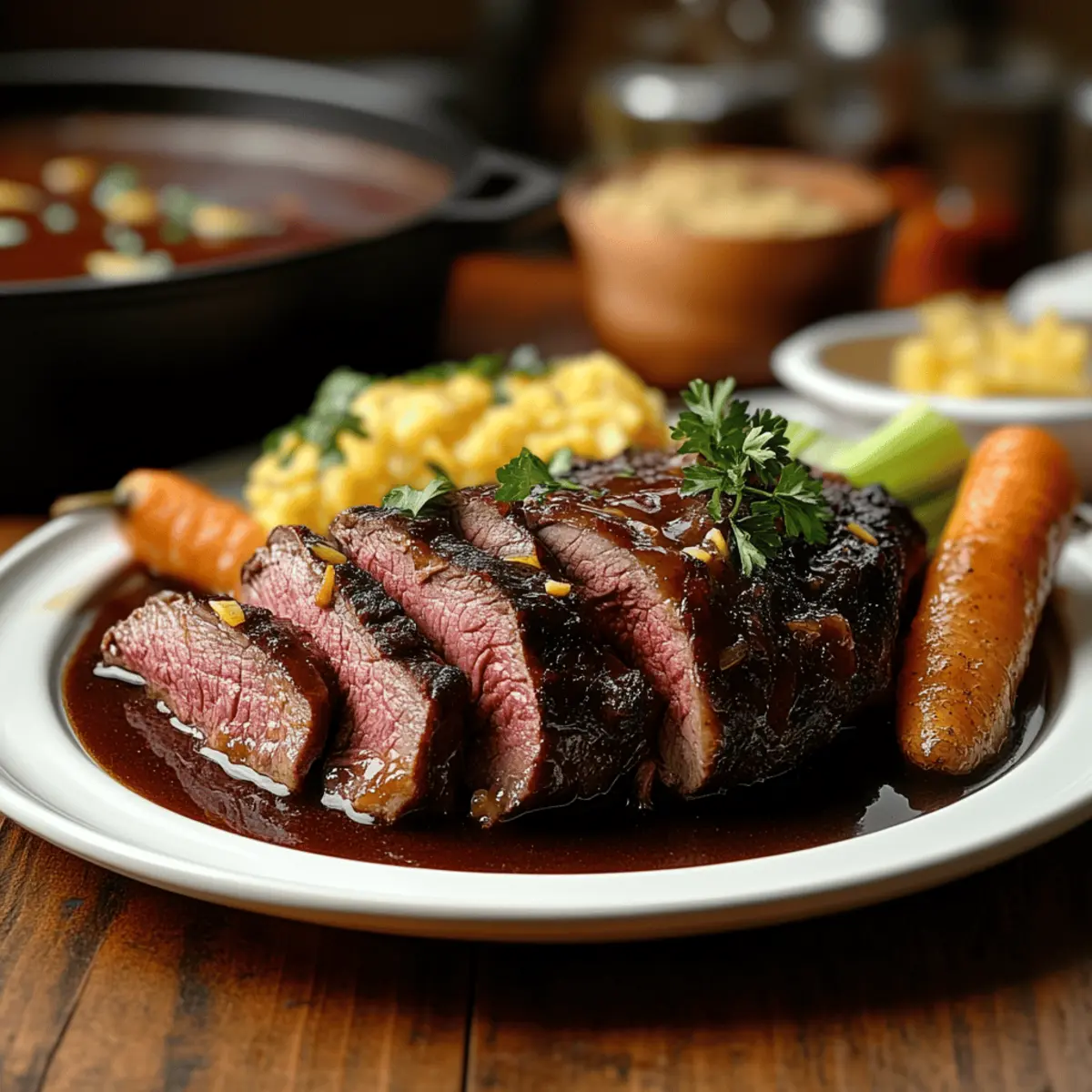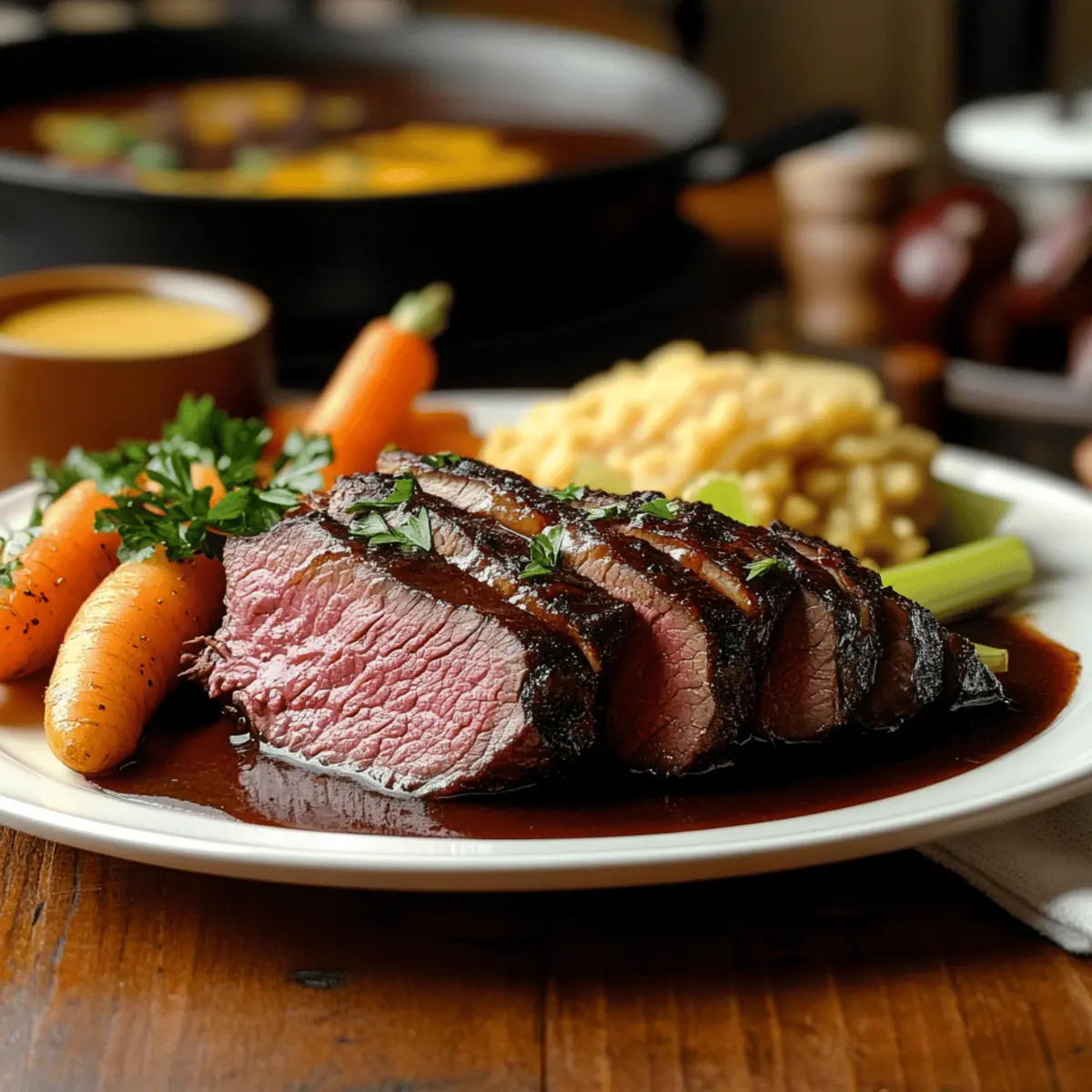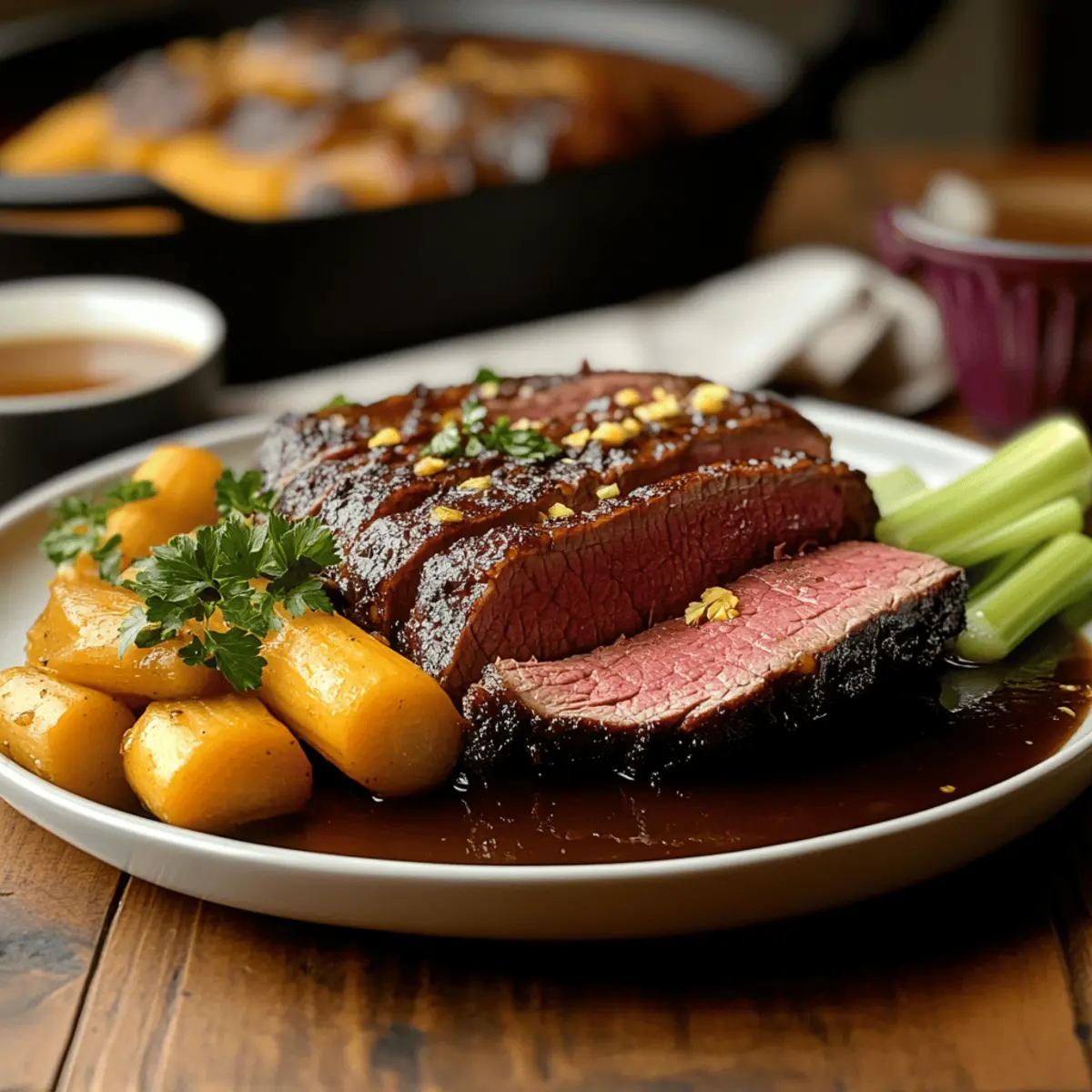As the aromatic scent of beef and spices fills my kitchen, I can’t help but feel transported to a cozy German household, where traditions linger like the warmth of a family gathering. Today, I’m excited to share my recipe for German Sauerbraten, a slow-cooked pot roast that brings the heart of German cuisine right to your dining table. The beauty of this traditional dish lies not only in its rich, tangy sauce but also in the tender, flavorful meat that practically melts in your mouth. Perfect for those special family dinners and easy enough to prepare over the weekend, this recipe is a comforting embrace of flavor that will leave your loved ones asking for seconds. Curious about the secrets behind that irresistible marinade? Let’s dive into the process and create a memory-filled meal together!

Why is German Sauerbraten so special?
Tradition at its Core: This German Sauerbraten is steeped in history, making it a beloved classic that’s perfect for family gatherings.
Unforgettable Flavor: The marinade imbues the beef with a tanginess that perfectly balances richness, ideal for those seeking something beyond ordinary pot roast.
Tender & Juicy: When cooked to perfection, each bite is an explosion of tender, succulent meat that practically melts in your mouth, a texture everyone loves!
Easy Meal Prep: With a simple marinade step that requires minimal hands-on time, you can savor a comforting meal while spending time with loved ones.
Versatile Serving Options: Pair it with mashed potatoes, spätzle, or red cabbage for a complete feast that’s sure to impress. If you’re curious about other satisfying slow-cooked recipes, consider exploring options that complement your Sauerbraten beautifully!
German Sauerbraten Ingredients
Discover the essential components for crafting a mouthwatering German Sauerbraten!
For the Marinade
- Vinegar – A key ingredient that delivers the signature tanginess essential for a proper German Sauerbraten.
- Water – Helps dilute the vinegar to prevent overpowering acidity in the marinade.
- Brown Sugar – Balances out the vinegar’s tanginess, rounding out the flavor profile of the marinade.
- Bay Leaves – Adds aromatic notes that enhance the depth of the marinade.
- Peppercorns – Infuses the marinated beef with a subtle spiciness for added dimension.
For the Roast
- Beef Roast (Chuck or Rump) – The star of the dish that provides a hearty, flavorful foundation; choose well-marbled cuts for optimal tenderness.
- Onions – Bring sweetness and depth to both the roast and the gravy as they cook down.
- Carrots – Contribute earthy sweetness to the dish while enriching the gravy.
- Celery – Adds a fresh, aromatic quality to the dish, enhancing the overall flavor.
With these essential German Sauerbraten ingredients at hand, you’ll be well on your way to cooking a dish that captures the heart of German cuisine!
Step‑by‑Step Instructions for German Sauerbraten
Step 1: Prepare the Marinade
In a medium saucepan, combine equal parts vinegar and water, adding brown sugar and your choice of spices like bay leaves and peppercorns. Bring this mixture to a boil over medium heat, stirring until the sugar fully dissolves. Once boiling, remove from heat and let it cool completely. This tangy marinade will impart incredible flavor to your German Sauerbraten.
Step 2: Marinate the Beef
Place your beef roast in a large bowl or a resealable Ziploc bag, and pour the cooled marinade over it, ensuring it’s fully submerged. If necessary, place a weight on top to keep it submerged. Seal the bag or cover the bowl tightly, and refrigerate for 3 to 4 days, turning the meat occasionally to ensure even marination and a deep flavor.
Step 3: Sear the Beef
After marination, preheat your Dutch oven over medium-high heat and add a drizzle of oil. Remove the beef from the marinade, allowing excess liquid to drip off. Sear the roast on all sides in the hot oil until it’s nicely browned, about 4-5 minutes per side. This step develops a rich, caramelized crust that enhances the overall flavor of the German Sauerbraten.
Step 4: Add the Vegetables and Marinade
Reduce the heat to medium and add chopped onions, carrots, and celery to the pot, sautéing for about 5 minutes until the vegetables begin to soften. Pour in the reserved marinade along with some beef broth, enough to nearly cover the meat. This mixture will form the base of the luscious sauce for your Sauerbraten as it cooks slowly.
Step 5: Braise in the Oven
Cover the Dutch oven with a lid and place it in a preheated oven at 325°F (163°C). Allow the German Sauerbraten to braise for 2.5 to 3 hours, until the beef is fork-tender and has absorbed all those delightful flavors. Check occasionally to ensure there’s still enough liquid in the pot, adding a splash of broth if it gets too low.
Step 6: Strain and Thicken the Sauce
Once cooked, carefully remove the beef from the Dutch oven and transfer it to a cutting board to rest for about 10-15 minutes. Meanwhile, strain the cooking liquid into a saucepan, discarding the solids. Bring the strained sauce to a simmer, reducing until it thickens slightly. If you prefer a thicker gravy, mix a cornstarch slurry and add it to the simmering sauce until you achieve the desired consistency.
Step 7: Slice and Serve
After resting, slice the German Sauerbraten against the grain into thin pieces for optimal tenderness. Serve it atop a bed of creamy mashed potatoes or with traditional red cabbage. Drizzle the thickened sauce over the slices, and watch everyone enjoy a comforting, flavorful meal that embodies the essence of German cuisine!

Storage Tips for German Sauerbraten
Fridge: Store leftover German Sauerbraten in an airtight container for up to 3 days. Keep the meat and sauce together for the best flavor retention.
Freezer: For longer storage, freeze the beef and sauce separately in airtight containers for up to 3 months. This helps maintain optimal texture and flavor when reheating.
Reheating: Thaw in the refrigerator overnight. Reheat gently on the stovetop or in the microwave until heated through, taking care not to overcook to maintain tenderness.
Make-Ahead: Consider making German Sauerbraten a day or two in advance; its flavors develop beautifully after resting in the fridge, making it an ideal dish for special occasions.
What to Serve with German Sauerbraten?
Add the perfect accompaniments for a comforting meal that will warm your heart and tantalize your taste buds!
-
Creamy Mashed Potatoes: A classic side that pairs beautifully, soaking up the rich, tangy sauce from the Sauerbraten. Each bite is a harmonious blend of flavors.
-
Spätzle: These delightful German egg noodles are perfect for capturing the gravy, offering a soft texture that complements the tender beef nicely. Their mild taste allows the Sauerbraten’s flavors to shine.
-
Sweet and Sour Red Cabbage: This vibrant side adds a lovely contrast with its sweetness and acidity, balancing the dish’s richness beautifully while adding a pop of color to your plate.
-
Roasted Root Vegetables: A medley of carrots, parsnips, and potatoes, caramelized to perfection, enhances the meal’s rustic feel while contributing sweet, earthy flavors.
-
German Beer: This traditional beverage enhances the dining experience; with its refreshing quality, it cuts through the meat’s richness, making each bite even more enjoyable.
-
Black Forest Cake: A decadent chocolate cake layered with cherries and whipped cream, serving as a delightful finish that adds a sweet touch to your hearty meal.
Elevate your Sauerbraten experience by pairing it with these cherished sides, and enjoy a full and satisfying feast that brings everyone together around the table!
Make Ahead Options
German Sauerbraten is an excellent choice for meal prep, allowing you to savor the deliciousness of this traditional dish with less hassle during busy weeknights. You can marinate the beef roast up to 4 days in advance, ensuring that each bite bursts with flavor. To do this, simply follow the marinade instructions and store the submerged roast in the refrigerator. If you prefer to cook ahead, the Sauerbraten freezes beautifully for up to 3 months—just make sure to store the meat and sauce separately in airtight containers to maintain their hearty quality. When ready to enjoy, simply reheat the roast in the oven at a low temperature, serve alongside your favorite sides, and revel in your effortlessly delightful meal!
German Sauerbraten: Customization Ideas
Feel free to personalize this mouthwatering recipe to suit your tastes and preferences!
- Sweet & Tangy: Add a splash of red wine to the marinade for an exquisite depth of flavor.
- Vegetable Medley: Toss in parsnips, turnips, or potatoes for a heartier dish that boosts nutrition.
- Spice It Up: Include a pinch of chili flakes if you crave a hint of heat in your German Sauerbraten.
- Herb-Infused: Incorporate fresh herbs like thyme or rosemary during braising for an aromatic twist.
- Dairy-Free: Swap traditional butter for olive oil in the sauce for a lighter, dairy-free version.
- Sweetness Adjustment: Increase the brown sugar to balance out the tang if you prefer a sweeter flavor profile.
- Slow Cooker Option: After searing the beef, transfer it to a slow cooker and let it cook on low for 6-8 hours for hands-off cooking.
- Sauce Variations: Experiment by adding a spoonful of Dijon mustard to the sauce for an added kick.
As you customize your Sauerbraten, be sure to explore other cozy slow-cooked recipes that can easily complement your creations!
Tips for the Best German Sauerbraten
• Marination Time: Don’t rush the marinade! Aim for a full 3-4 days in the refrigerator to ensure deep, tangy flavors permeate the meat.
• Full Submersion: Make sure the beef is completely covered by the marinade for even flavor distribution; use a weight if necessary.
• Searing is Key: Sear the roast well on all sides. This step creates a delicious crust, adding depth to your German Sauerbraten’s flavor profile.
• Braising Liquid Levels: Keep an eye on the liquid in your Dutch oven while braising; add beef broth if it gets too low to avoid burning.
• Resting for Perfection: Allow the meat to rest for 10-15 minutes after cooking. This step ensures every slice is juicy and full of flavor.

German Sauerbraten Recipe FAQs
How do I select the right beef roast for German Sauerbraten?
Absolutely! For the best results, I recommend using a chuck roast or a rump roast. Look for well-marbled cuts that have a good amount of fat running through them, as this will help keep the meat tender during the long cooking process.
How should I store leftover German Sauerbraten?
You can store leftover Sauerbraten in an airtight container in the refrigerator for up to 3 days. Make sure to keep the meat and sauce together to retain their delicious flavors. If you’re planning to enjoy it later, freezing is a great option!
Can I freeze German Sauerbraten?
Very! To freeze your Sauerbraten, let it cool down to room temperature, then place the beef and sauce in separate airtight containers. It can be stored in the freezer for up to 3 months. When you’re ready to enjoy it, thaw in the refrigerator overnight before reheating.
What if my Sauerbraten is too tangy?
If you find the flavor too sharp due to the vinegar, you can balance the tanginess by adding a little more brown sugar or even a splash of red wine into the sauce while it simmers. Taste as you go to find the perfect balance for your palate!
Can I give German Sauerbraten to my pets?
While the beef itself can be safe for pets in moderation, the marinade (especially from vinegar and spices) may not be suitable for them. It’s best to serve your furry friends plain cooked meat without any seasoning. Always consult your vet for dietary concerns.
What should I do if my sauce isn’t thickening?
Don’t worry! If the sauce isn’t thickening as you’d like, you can simply create a cornstarch slurry. Mix 1 tablespoon of cornstarch with 2 tablespoons of cold water until smooth, then add it to the simmering sauce, stirring continuously. Let it cook for a few more minutes, and you’ll have a lovely, rich gravy in no time!

Tender German Sauerbraten: A Flavorful Family Comfort Dish
Ingredients
Equipment
Method
- In a medium saucepan, combine vinegar and water, adding brown sugar, bay leaves, and peppercorns. Bring to a boil and stir until sugar dissolves. Remove from heat and cool.
- Place the beef in a bowl or Ziploc bag and pour cooled marinade over it. Ensure the beef is submerged and refrigerate for 3 to 4 days, turning occasionally.
- Preheat Dutch oven and add oil. Remove beef from marinade and sear all sides until browned, about 4-5 minutes per side.
- Sauté onions, carrots, and celery in the pot for 5 minutes. Pour in reserved marinade and beef broth to cover the meat.
- Cover and braise in an oven preheated to 325°F (163°C) for 2.5 to 3 hours, until fork-tender.
- Remove beef and let it rest for 10-15 minutes. Strain cooking liquid and simmer to thicken.
- Slice beef against the grain and serve with sauce over mashed potatoes or red cabbage.

Leave a Reply